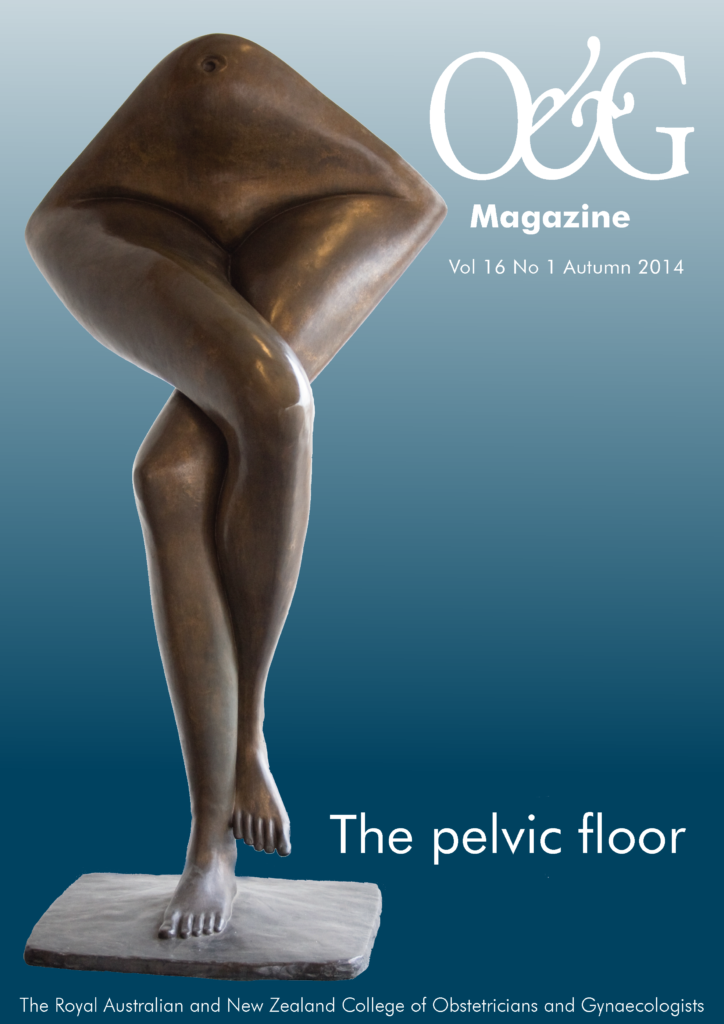Does episiotomy still have a role to play in preventing injury to the pelvic floor during birth?
A recent newspaper article has highlighted the issue of performing an episiotomy during a normal birth – especially when done without the woman’s consent. Amy Herbst is an American opera singer who gave birth to a boy in an Army hospital in Kentucky, USA, in 2012.1 She was reported to be suing the government for $2.5 million for having a procedure (episiotomy) that was not discussed with her and has left her with anal incontinence and dyspareunia. Aside from the issue of informed consent, it is interesting to see the link being made between the use of episiotomy and resulting incontinence and dyspareunia. It seems we have come a long way from the 1970s and 1980s, when episiotomy was commonplace and considered to be the best way of avoiding severe perineal tears and pelvic floor trauma.
Driving the change has been research demonstrating that a policy of routine episiotomy does not prevent severe perineal trauma or morbidity during normal birth. The latest Cochrane systematic review on the subject2 reported on eight studies, involving 5541 women, comparing routine episiotomy with restricted use of episiotomy concluded: ‘restrictive episiotomy policies appear to have a number of benefits compared to policies based on routine episiotomy.’ Findings included less posterior perineal trauma, less need for suturing and fewer postpartum healing complications. No differences were found in pain measures or the incidence of severe vaginal or perineal trauma, but an increased risk for anterior perineal trauma was noted in the restricted group. Anterior perineal trauma is usually associated with minimal long-term morbidity. Thus there is clear evidence to recommend restrictive use of episiotomies during normal birth, although further trials are needed to explore the optimal use of episiotomy during assisted births, preterm and breech births and births where there is an expectation of a large baby or an imminent tear.
Despite this evidence, episiotomy is often reported as being the most commonly performed surgical procedure in the world and there is wide variation and variability in rates of episiotomy between countries. In Europe the rates of episiotomy for women having a vaginal birth in 2010 varied, with a high of 75 per cent in Cyprus (other countries at about 70 per cent included Poland, Portugal and Romania), rates of 43–58 per cent were reported in Flanders, the Czech Republic and Spain, while rates of between 16 per cent and 36 per cent were reported from England, Wales, Scotland, Finland, France, Germany and Switzerland.3 The lowest rates were reported as 4.9 per cent in Denmark and 7.2 per cent in Sweden and Iceland. Most of these countries have seen a reduction in their use of episiotomy since 2004, in line with the Cochrane recommendations.
New Zealand and Australia have national rates that are comparable to the moderately low European countries, with New Zealand reporting episiotomy rates of 12.5 per cent in 2010 and Australia 16.3 per cent (this included episiotomy and laceration).4,5 The New Zealand College of Midwives publishes a report annually outlining the clinical outcomes for midwife members who work as a Lead Maternity Carer and provide continuity of care to a caseload of women. The 2011 report provides data from 866 midwives who provided care to 31 739 women, of these women 8.6 per cent had an episiotomy, a further 50 per cent of women had an intact/grazed perineum with 2.3 per cent having a third-degree tear and 0.2 per cent a fourth-degree tear.6 Australia has similar statistics, with the rate of third- and fourth-degree tears varying between regions from a low of 1.1 per cent to a high of 3.0 per cent, resulting in a national rate of 1.8 per cent for 2010.5
Primiparous women are more likely to have an episiotomy so it is useful to compare rates of episiotomy for the standard primiparous woman. The Australia and New Zealand clinical indicators have identical definitions supporting comparison and demonstrate an episiotomy rate of 30.3 per cent in Australia and 19 per cent in New Zealand, with a further 4.8 per cent in Australia and 1.1 per cent in New Zealand of women having an episiotomy and a third- or fourth-degree tear (or repair).7,8
Reducing perineal trauma during normal births
Factors that may increase the risk of perineal trauma are nulliparity, prolonged second stage and malposition. However, there are many other aspects of the second stage that should be considered when discussing increased/decreased perineal trauma – these include maternal position during the second stage, fetal size and position and the speed of the descent of the presenting part.
In New Zealand, when working in partnership with women, midwives will discuss various aspects of the second stage. This discussion generally involves talking about finding the most comfortable positions during labour and birth, with advice that the woman should adopt the position most comfortable for her at this time. This concept has been supported by Gupta and Hofmeyr9 in their review of position during the second stage of labour. Personally, I have found when women are supported to adopt a position of comfort they will frequently give birth in a kneeling or hands-and-knees position.
As midwives, we have often been taught to put pressure on the baby’s head at crowning to support flexion of the head while simultaneously guarding the perineum by placing a hand/swab against it as support. This is obviously easier to do when a woman is in a semi-recumbent position or lying on her side. Comparisons of this technique with a hands-off approach are included in a Cochrane review of perineal techniques during the second stage of labour to reduce perineal trauma.10 The review found that hands off or hands poised did not have a significant effect on third- and fourth-degree tears. What was found to help reduce third- and fourth-degree tears were warm compresses to the perineum during the second stage. In my midwifery practice, it will depend on the woman’s position and speed of descent of the presenting part as to whether I place hands on the baby or the perineum, and whether or not I can provide warm compresses to the perineum.
Another issue that needs consideration is the speed of the descent of the presenting part during the second stage. Perineal tissue needs time to stretch to its fullest potential during the second stage. A slow, steady progressive descent of the presenting part will help maximise the stretch and minimise trauma. So patience and positive encouragement are necessary along with a discussion with the woman about the need to stay in control when pushing. Frequently, once the head has crowned, midwives will encourage the woman to breathe or pant rather than push to ensure a slower descent of the head at this point. Pushing and bearing down methods are the subject of a Cochrane protocol that will aim to compare directed pushing during the second stage with supporting the woman’s instinctive responses.11 It will be interesting to see the results of this review once it is completed.
The size of the baby and optimal position for labour may also have an impact on perineal trauma. As such, we need to review BMI and fetal occipital posterior positions when considering perineal outcomes, especially in view of the increasing trend towards obesity that is currently occurring in both New Zealand and Australia.
In summary, perineal trauma often occurs spontaneously during birth, although obviously avoiding episiotomy can reduce the incidence of unnecessary perineal trauma. The incidence of severe perineal trauma, resulting in longer term morbidity, appears to be low. It varies between countries, often owing to differences in definitions and practice. However, the resulting pain and discomfort and longer term morbidity has a major impact for women so we need to continue to discuss and debate the optimum means of reducing perineal trauma during birth.
References
- Daily Mail reporter. www.dailymail.co.uk/news/article-2544206/ Opera-singer-suffered-botched-episiotomy-led-excessive-flatulence-left-unable-perform.html. Accessed January 2014.
- Carroli G, Mignini L. Episiotomy for vaginal birth Cochrane Database of Systematic Reviews [Internet]. 2009; Issue 1:Art No CD000081 .
- Euro-Peristat Project with SCPER and EUROCAT. The health and care of pregnant women and babies in Europe in 20102013 23rd September 2013. Available from: www.europeristat.com .
- Ministry of Health. Report on Maternity 2010. Wellington: Ministry of Health, 2012.
- Li Z, Zeki R, Hilder L, Sullivan E. Australia’s mothers and babies 2010. Canberra Australian Institute of Health and Welfare 2012.
- New Zealand College of Midwives, Midwifery and Maternity Providers Organisation. New Zealand College of Midwives Report on MMPO-Midwives Care Activities and Outcomes 2010. Christchurch: New Zealand College of Midwives, Midwifery and Maternity Providers Organisation, 2011.
- Australian Council on Healthcare Standards. Australasian Clinical Indicator Report 2004-2011: 13th edition. Sydney: Australian Council on Healthcare Standards, 2012.
- Ministry of Health. New Zealand Maternity Clinical Indicators 2011. Wellington: Ministry of Health, 2013.
- Gupta J, Hofmeyr G, Shehmar M. Position in the second stage of labour for women without epidural anaesthesia. Cochrane Database of Systematic Reviews. 2012; Issue 5:Art. No: CD002006.
- Aasheim V, Nilsen A, Lukasse M, Reinar L. Perineal techniques during the second stage of labour for reducing perineal trauma. Cochrane Database of Systematic Reviews [Internet]. 2011; Issue 12: Art No CD006672.
- Lemos A, Amorim M, Dornelas de Andrade A, de Souza A, Cabral Filho J, Correia J. Pushing/bearing down methods for the second stage of labour (Protocol). Cochrane Database of Systematic Reviews. 2011; Issue 5:Art No CD009124.






Leave a Reply